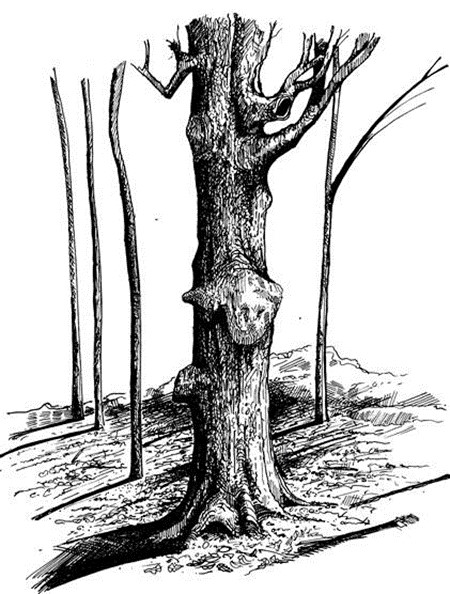There is a space between trees, a distance between where the tips of their branches touch and the light shines through. This space between living wood evokes a world beyond the physical, and sometimes, if we can train our vision, it suggests a place of memory and even of hope.
Throughout the 1980s, I lived off of Peters Road in Knoxville, Tennessee. Peters was lined with gnarled white oaks that leaned over and created shade on both sides of the road, especially in late summer, and during the fall, piles of acorns would line its asphalt. At Peters Road’s junction with Kingston Pike, a major Knoxville thoroughfare, stands the Baker-Peters house.
Built in the 1840s and constructed in a Greek-Revival style, the Baker-Peters house has long been a landmark of the town. Its original owner, Dr James Baker, was suspected of secessionist loyalties for treating wounded Confederate soldiers in the house during the Civil War. As a result, Union troopers raided Baker’s home in 1864, shooting and killing him in his foyer. Dr Baker’s untimely demise, and the home’s distinction as a Civil War hospital, have added to tales of hauntings and ghostly visitations. To my eyes, however, the most remarkable aspect of the house was neither the interior’s bullet-pocked walls nor its white-columned facade. Instead, I marvelled at what stood in the front yard of Baker-Peters. Growing in the homestead’s right corner, adjacent to Kingston Pike, stood a large rock elm that thrived in the summer and turned a vibrant yellow in autumn. The elm served as a signpost to West Knoxville, and people who lived off Peters Road would invariably say, “turn at the giant tree,” when giving directions. It had witnessed two centuries of Tennessee history. From the creation of the pike to Dr Baker’s murder, the tree had weathered storms and war, depressions and economic booms. In the end, though, the elm succumbed to a fate that has claimed much our American natural heritage – suburban sprawl.
For years, Baker-Peters House operated as a restaurant called Hawkeye’s Corner, Too, but in 1989 Phillips Gas Company purchased the property. Originally, corporate needs called for the house to be razed and all of the gardens turned over and replaced by a Phillips 66 gas station. Historic preservation groups rallied behind Baker-Peters and a compromise was agreed upon. The house would be saved, but the rock elm would have to be cut. Phillips Gas argued that the tree was suffering from Dutch elm disease, so one day in the summer of 1989, 200 years of living history came crashing down. Dozens of people came out to witness the removal, but to everyone’s surprise arborists did not chop the tree in one mighty swath, calling out the clichéd timber as it fell. Instead, they dismantled the elm, limb by limb, from top to bottom, like a surgeon cutting out a gangrenous infection. By late afternoon, the elm was boughless, more flag pole than a tree, and as the crowd began to disperse men began in earnest to hew at the trunk, section by section. They worked into the night, and the following morning nothing remained of the elm. Even the stump was ground into a pulp. Within a month, excavating crews were installing pumps, and by winter a new, tin-topped gas station opened in the front lawn of Baker-Peters.
The oaks that lined Peters Road next to the house were lost soon after. When the Tennessee Department of Transportation was planning to widen the road, I remember the exacting orange tape that was strung around each tree, sealing their fates. The agency made quick work of them and by the end of a second day’s work, crews had grounded at least ten of the giants. The day after they were cut, I walked from stump to stump and counted growth rings. Their ages were staggering: 167, 175, 181…. Though I have come to realize that a 180-year-old white oak tree is not quite ancient – they can live well over 300 years – at the time, I viewed their loss as the most grievous of crimes. How could trees of this great age and, intrinsic worth, be felled and forgotten for a road project?
In the thirty years since the loss of the Baker-Peters elm and the Peters Road oaks, I have often thought about those ghost trees, still visible to me beyond the stretches of time, gas pumps, and four-lane avenues. I have wished that there had been at least a catalogue to their remembrance, a picture gallery to hang as the token to those very real emblems of America’s past and present realities. Many trees that still grow in the southeastern United States share an ageless connection with those Knoxville oaks and elms. Some were seedlings in the early years of the union. Others, however, are so old that if they could speak in a human tongue they would know the languages of Cherokee and Muscogee, Shawnee and Catawba. A study of relic forests can never be exhaustive because many of these distinctive trees live in the solitudes of private properties and are known only to crows and rain. Others have been hiding in plain sight for generations, and they remain the special delight of people who take to the woods or of farmers occupied in their daily trades. Steadfast and grounded, these trees have lived through the nation’s changes, and they act as links to that verdant past, which slips further and further beyond memory. Even after my youth in Knoxville, I continued to seek out these living monuments.

Hawkeyes Corner, Too by Ralph Johnston IV. Used with the author’s permission.
Years after the loss of the Peters elm, I taught high school English in McDonough, Georgia. Located 40 miles south of metropolitan Atlanta, the town and surrounding county experienced exorbitant growth in the early years of the twenty-first century. Fueled by low housing costs and a thriving economy, the county was quick to replace its traditional agriculturally based culture with a suburban identity. As a result, acres upon acres of fields and stout woodlands were subdivided into new neighbourhoods and gated communities. Though Henry County embraced its New South character of contemporary housing developments set against pastoral farmlands, lingering untouched woods remained. Not many, but a few timeworn plots of oak or beech can still be found speckled between subdivisions and school grounds.
I lived about two miles from campus. When the weather was mild, I would walk to work, following the school’s cross-country jogging trail that cut through an overgrown field that was becoming a thicket of scrubby oaks, black willow, and English privet. After winding through the tangle for half a mile, the path entered into more mature woods. Privet and honeysuckle gave way to stands of sweet gum, dogwood and tulip poplars. Continuing on, the path ran behind the school grounds next to a low, leave-strewn creek before it emptied out near the sports fields.
Once the path opened up at the fields, walkers had unimpeded views out beyond the bus rows and teacher parking lot toward a busy two-lane, Hampton Locust Grove Road. Across the road, loomed the white-washed sides of the Weems plantation house. Built in 1848 by Samuel Weems, the property is estimated to have originally encompassed over 4,000 acres. In 2011 the grounds gained acclaim when locals rediscovered a slave cemetery in a wooded tract behind the home place. Over 185 bodies are buried there, making it one of the largest enslaved person cemeteries in the South.
Though most of the Weems property has been partitioned off and developed, across from the main house, a patch of land remains seemingly untouched. For much of the year, the plot takes on a monotonous tint of green as trees closest to the road create a wall of loblolly and sweet gum. Its interior remains hidden from view, but as seasons give way, the woods start to open up. About twenty yards off of the road, secreted away from the bustle of the century, grows one of the county’s most impressive white oak groves. For years I had driven by the site, unconscious of its presence, until one November I happened to peer into the timber as I passed. A stand of large trees flashed from within the woods’ centre. Instinctively, I pulled over to get a closer look. The trees were located on private property, so I walked up to the adjacent house and knocked on the door. After my fourth knock, an elderly woman opened the window next to the front door. She craned her head out.
“May I help you?” she asked.
“Yes, ma’am, do you own the property next door?”
She hesitated and then replied, “Yes. It has been in my family for many years.”
“I understand that this was part of the Weems homestead.”
“Yes, it was, and it still is. I am Mrs Weems.”
I went on to tell Mrs Weems about my love of old trees, and she told me that the acres next to her house had been woods for as long as she could recall and were likely growing before the plantation was surveyed. She went on to say that I was welcome to explore back there anytime.
“Nobody ever goes in there. Just watch out for snakes. I hoed a copperhead in my yard last week,” she warned.
Stepping through the brambles and briars, I entered a forgotten place. Even though most of the foliage had fallen off of the limbs, the light seemed to grow darker the further in I walked. Past the initial brushy points and low hedges, the woods unfolded with ripe oaks, heavy with acorns. And then, there it was.
Near the centre of the stand stood a great mother oak. It boasted a diameter of over four feet and shot up to well over 80 feet tall. How long had it stood here? Ageing trees has never been an exact science, especially for trees growing in the woods, but given its size and the surrounding thick soil duff and squat underbrush, I estimated it to be well over 200 years. Its thick grey bark and sinuous crown spoke of centuries, not decades, and it was not alone. All around the mother tree were other knotty oaks and hickories.
Stepping into this wood was like walking through a portal into another place, another dimension. Even though I could still see and hear the cars zip along Hampton-Locust Grove Road, the silence of that space was heavy and, to be honest, most wonderful.
I suppose one could dismiss such feelings about old woods as quaint and burdened with a romantic gushing for the past, yet there is always a palatable impression that one encounters when entering an aged timber. After all, many of our own cultural traditions recognize this sentiment and the western world brims with allusions to a past that was heavily laden with renown for clusters of large trees and plantings of sacred groves. Druids of western Europe and the British Isles worshipped trees, and they viewed themselves as protectors of their groves. This arboreal lineage still lives in our hearts, and coming across remnants of a living past, one confronts the image of a foundling, a child born alone in a wood and raised on a tonic of wildness.
For now, trees like the Weems oak still hold their vigils in tucked away corners of the country, but every year more of them go the way of the Peters Road oaks – lost and forgotten. So everywhere I travel in America’s crowded East, I remain on the lookout them. I peer deep into pastures and overgrown backlots, ever watchful for these green temples hiding in plain sight along the roadsides of American. They wait to be rediscovered, and they wait for their stories to be told, these link-chains to our common history – these emissaries of living hope.

White Oak, by Ralph Johnston. Image used with the author’s permission.











